|
August
24
We woke up early to a beautiful morning.
The sky was clear and the wind had died down, so the
surface of the lake was much calmer.
There were half a dozen ducks bobbing in the water near our
cove. We went fishing, even before morning coffee. I
was just enjoying the idyllic setting, but George was really
determined to catch a fish.
Casting
the spinning rod from the shore, I experimented with how fast to
reel the line in; reeling slow would hook the pebbles on the
bottom and let you at least think you had something for a moment.
At least I was getting more consistent with my casts.
Just as we were considering giving up and going to fix
breakfast, George caught a lake trout, about 12 inches long.
At last! This
gave us incentive to keep fishing.
I moved further down the shore.
The mountains, bathed in sunlight, were set against a
brilliant blue sky. The
water was a rich turquoise color, and the far shore was rimmed
with that silver glowing line of reflected light.
As usual I alternated between fishing and taking photos - I
think George thought this somewhat of a sacrilege.
Presently I noticed a disturbance
on the surface of the water near where I was casting.
Looking closely, I could see it was a group of tiny
minnows, swimming rapidly in circles.
Maybe if there are little fish, I thought, big fish will be
lurking around to eat them. I
cast right past the minnows, and pulled the line in through the
churning frenzy. Then
suddenly, bam! I
felt a hard jerk on my line, and I jerked back. I
had hooked a fish!
Holy
crap! I have a fish!
What do I do now?
The
fish was leaping and fighting as I reeled him in, but I managed to
land him. He was big,
about fifteen inches. George
and Jineen were there to cheer me on as I caught my first ever
fish. I hadn’t even
been sure I liked fishing, but heck, this was fun!
We had fried lake trout for breakfast, and it was awesome.
Rolled in flour, then dipped in egg, then rolled in
Bisquick, and fried up in one of the heavy iron skillets.
It was the best breakfast I ever had.
(Yes, I know, I said that yesterday about the blueberry
pancakes.) There is
nothing like fried fish for breakfast, caught, cleaned, cooked and
consumed all within the hour.
And I caught the biggest fish!
Well, I’m not sure it’s really fair to say I
caught him; George provided the gear, taught me how to cast, put
on the lure, took the fish off the hook, and knocked it in the
head so it wouldn’t suffer.
Then Jineen cleaned it, filleted it, and cooked it.
But hey, I will take the credit!
|

I caught a fish! |
After breakfast we took the boat across the lake to Hope
Creek, near Dick’s cabin. George
stayed on the shore to fish for grayling while Jineen and I went
hiking. Our path
started out through the woods alongside Hope Creek, but soon
turned up a steep slope, climbing up the side of the mountain via
a series of switchbacks. It
was a plain trail, easy to follow - very different from the
previous two days’ hiking.
We followed the switchbacks up
through fields of blueberries.
Some areas were full of ripe berries, while other had been
grazed by the bears - the tips of the branches were all nipped
off. We called out.
“Hello Mr. Bear! Or
maybe Mrs. Bear?” We
stopped to pick berries for more pancakes.
“Don’t worry, Mr. and Mrs. Bear, we are only taking a
few blueberries, and there are plenty for all.”
It is important to reassure the bears.
We
came up onto the Cowgill Benches, a series of half a dozen broad
flat plateaus, terraced into the mountainside overlooking the
lake. Dick Proenneke
had often referred to hiking the Cowgill Benches in his book One Man’s Wilderness.
We
were above the timberline, and wide open vistas stretched before
us. We paused on the
first ledge, admiring the scenery.
As we continued up bench after bench, we found that the
views got better with each elevation gain.
We stopped on the third bench and sat for a while, just
soaking it all in. It
was utterly peaceful; the silence was broken only by the light
breeze and a few birds, and we could see no signs of civilization.
|
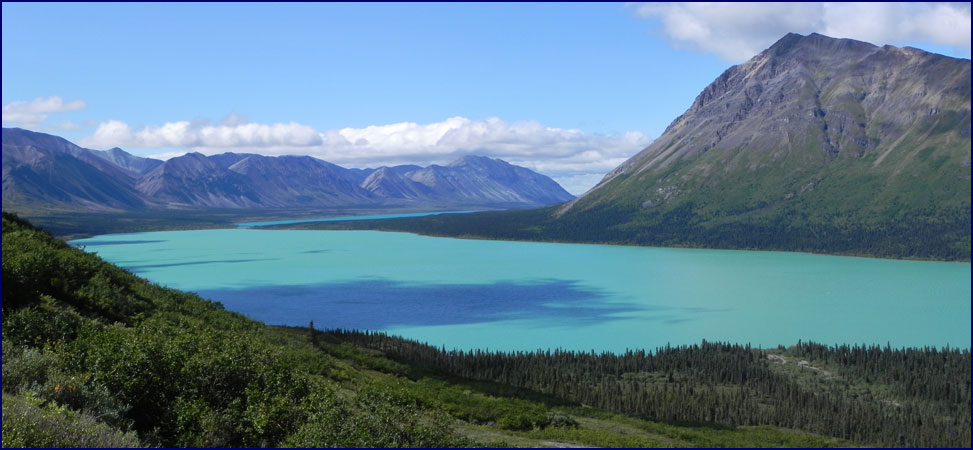
The view from the Cowgill Benches. |
The twin turquoise lakes stretched out below us, majestic
peaks rising above. The
mountains across the water were a swirl of browns and grays, like
paint being mixed on a palette. We could see glimpses of glaciers
and snow fields amid jagged peaks.
The sky was blue, the sun was shining, and the world was at
our feet. Life
doesn’t get much better than this.
We were sorry George wasn’t with us.
We continued up through blueberry fields, talking and
calling out as we went, especially when crossing ridges or gullies
where we couldn’t see far ahead.
“Hey Mr. Bear!” We
were discussing the downside of following safe bear protocol; if
you make noise to warn them of your approach then you don’t get
a chance to see them.
“Well there’s one now,” Jineen said conversationally.
Sure enough, a black bear was poking his head up over the
ridge, about fifty yards in front of us.
He stared down at us for a second, and we stared up at him,
and then he ducked back below the ridge out of sight.
A few seconds later he poked his head up again, a bit
further down the slope, checking us out. Then he took off down the
creek.
|

Well, there's one now! |
We veered uphill, seeking higher ground.
Once we were safely above where we’d seen the bear, we
stopped and scanned the area.
(I’m not sure why being above the bear felt safer; did we
think bears can’t run uphill?)
Soon the bear appeared again, coming out of the gully below
us, about 100 yards away. He
meandered slowly along, pausing to graze on the blueberries.
He would lie down to eat, biting off the ends of the bushes
- berries, leaves, twigs and all.
When he had eaten all the berries he could reach, he would
get up and move to a new patch.
He glanced up at us occasionally, but seemed unperturbed by
our presence.
We
were reassured by the fact that this was a black bear; they have a
much less fearsome reputation than the Alaskan brown bear
(grizzly). Brown bears
can be very territorial and unpredictable, and are more likely to
attack, but black bears can also be dangerous.
In fact, an Alaskan old-timer had told me once that black
bears are actually more troublesome, because occasionally they
will stalk people. “A
black bear, he’ll hunt you and eat you,” he said.
“Where a grizzly, well, he’ll just ruin your day.”
|
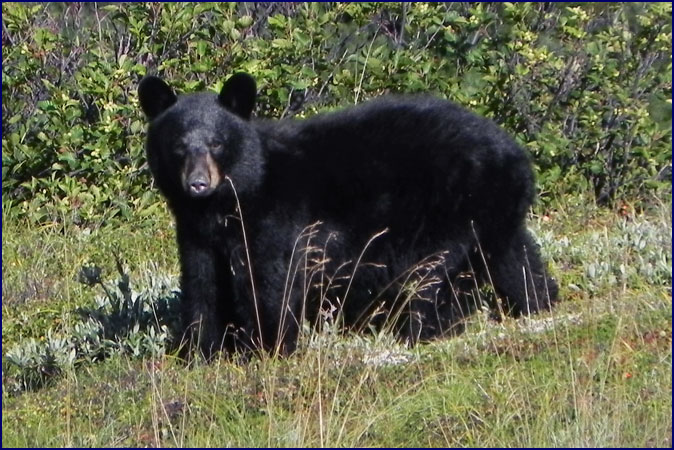
We met this fella on the Cowgill Benches. |
We stood watching the bear for quite a while, taking
photos. He looked up
at us again, nonchalantly, and started moseying up the trail in
our direction, stopping along the way to eat more berries.
I was finally getting my chance for some close-up
bear photography.
The bear continued toward us, more
purposeful now, peering up at us and sniffing the air.
He was now less than 75 yards away.
We had read that it is illegal in Alaska for hikers to
approach a bear closer than a quarter of a mile.
Did the bear know the law?
I suspected not. We
were starting to get a little bit nervous. Bears have poor
eyesight, but very keen senses of hearing and smell.
Was he stalking us? Being
eaten by a bear seemed a particularly poor way to go.
|

Was he stalking us? |
Enough close up photos; it was time for some action.
We decided to have a little talk with the bear.
Jineen and I checked that our bear spray was within easy
grasp, and stood close together with our arms above our heads in
order to appear big.
“Hello, Mr. Bear.
Just wanted to let you know, we have pepper spray, Mr.
Bear!!” I called
out loudly. Upon
hearing this news he looked at us, sniffed the wind once more, and
deciding discretion was the better part of valor, he loped away
down the mountainside.
Wow, that was awesome!
We were sorry George had missed it.
We waited for a while hoping for another glimpse of the
bear, but he was long gone. We
could see two hikers with a dog over on the ridge on the far side
of Hope Creek, more than a quarter mile away, looking our way with
binoculars; we joked that they would probably go tell George we
were up here with a bear. And
him not along with his gun!
We continued on the little path up the mountainside, and
then scrambled off-trail up over rough tundra to a big square
standing rock at the bottom of the scree slope.
From here we had a good view of both lakes and the rows of
mountain peaks and glaciers beyond.
We sat on the rock and ate leftover blueberry pancakes.
Two Dall sheep, far across Hope Creek, stood out brilliant
white against the brown mountainside.
Dark cloudshadows raced across the turquoise surface of the
lake. We felt close to
heaven.
We found a faint path that rounded the shoulder of the
mountain and continued up the Hope Creek valley.
The trail became steeper and more treacherous as it
traversed a series of gullies and ridges, crossing slippery scree
slopes. The brushy
gullies would provide cover for bears, so we kept talking in case
they were listening. “Hello
Mrs. Bear, was that your husband we met earlier? A fine handsome
fellow he is!”
We came to a viewpoint where we could see further up
through the valley. Steep
mountains rose up on either side of Hope Creek, and around a
corner another vale opened up to the side.
We could see the Dall sheep again, now far ahead - or
perhaps these were different ones.
The trail went on, and we longed to follow it and explore
the valleys - but unfortunately it was getting close to the time
we had arranged to meet George so we had to head back.
We made our way back down the
mountain, pausing to pick blueberries for tomorrow’s breakfast.
George was in the boat when we reached the lake shore.
“I hear you were up there with a bear!” was the first
thing he said when he saw us - the hikers on the far ridge had
indeed come by with a bear report.
George had a successful day’s fishing – he had caught
half a dozen graylings where Hope Creek flows into the lake.
He had kept three for dinner and released the rest (he
later hinted that some of the releases may not have been entirely
voluntary).
|

George fishing for grayling. |
Sorry that George had missed the stunning landscape, we
talked him into going back up on the Cowgill Benches with us.
We took the boat across the lake to get George’s hiking
boots (he wouldn’t get far hiking in his waders) and clean the
fish, then back over to Hope Creek.
We headed up the trail again; somehow the slope seemed a
little steeper the second time around. George
left his gun behind since we had already scared away the bear.
We hiked up as far as the second bench, from where we could
see the whole upper lake. We
sat and watched the late afternoon light playing across the
mountains, with colored clouds glowing in the radiant sky.
Back at Windsong, Jineen and I each took a much needed
shower. The solar
shower unit was somewhat less sophisticated than the name would
lead one to believe; you filled a plastic bladder with water and
left it out in the sun hoping it would warm up, and then you hung
it up and showered with it. Perhaps
it would work better in a warmer climate; after being in the sun
all day our water had warmed up to a toasty 45 degrees, so the
showering was invigorating, to say the least.
We
had a leisurely happy hour, with wine and chips.
George taught the jays to land on his head and eat off of
his hat. We battered
and fried the grayling for a late dinner; they were delicious.
The milk and other perishables were still fresh after
almost five days without refrigeration; it made us realize how
well we could do without such luxuries as refrigerators,
electricity, and showers.
After dinner we walked down to the
edge of the lake. It
was a clear night full of brilliant stars, and Cygnus the Swan
flew high overhead. We
stood on the dock and savored the night, with a soft wind on our
cheeks and the moon reflecting in the water.
We made our last outhouse trip at midnight, mindful of
bears.
August
25
This was our last morning at Twin Lakes; the plane was to
pick us up after lunch. We
had been going hard and were tired, but we were sorry that it was
our last day in this beautiful place.
The
sky was crystal clear, and for the first time there was no wind.
I took my camera and went down to the shore.
The lake was absolutely still, and the mountains were
perfectly reflected in its mirror surface.
The ever-present silver line rimmed the lake, separating
reflection from reality. It
was breathtaking, magical, like a scene out of a dream.
|

Magical morning |
We made blueberry pancakes again, the best ever.
The jays joined us for our last breakfast at the cabin.
We packed up all of our leftover food - eggs, fruit, bread,
cheese and veggies - and took it across the lake to Dick
Proenneke’s cabin to give to Laurel, who was very appreciative. Crossing
in the boat, we marveled at the looking-glass surface of the lake,
and the amazing panorama of mountains reflected in it.
We visited Dick’s cabin again,
and Laurel showed us around. We were impressed anew at the
craftsmanship that went in to building it.
“I hear you were up on the Cowgill Benches with a bear
yesterday,” Laurel said. My,
how word gets around!
|
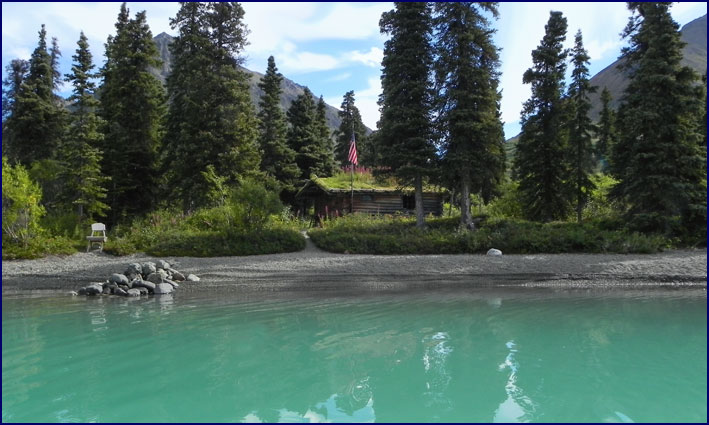
Dick Proenneke's cabin |
We hiked up the Teetering Rock trail, which Laurel had said
was one of Dick’s favorite places to take visitors.
The path started behind his cabin and followed the creek
through the woods, before ascending the mountainside in a series
of switchbacks, climbing through blueberry fields and a sparse
scattering of spruce trees. We
were on the opposite side of Hope Creek from the Cowgill Benches.
As we got higher the views were fantastic, similar to the
previous day but from a different perspective.
|
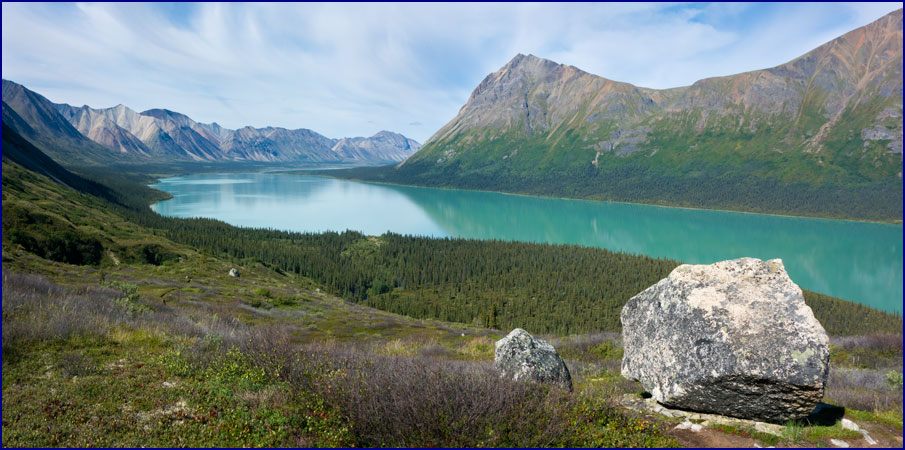
Teetering Rock |
It was a considerable climb, but on a plain trail that was
easy to follow. We
went along the open ridge, in the same area where we had seen the
two hikers the previous day. Presently
we came to Teetering Rock, a big slab of stone that was
precariously balanced on an outcropping.
You could climb up on the boulder and shift your weight,
making the rock teeter back and forth, a disconcerting feeling at
best. We took turns
teetering the rock. Wanting
a group photo, I used George’s gun as a tripod to take a timer
shot of the three of us by the rock.
Then we just sat for a while, enthralled by the beauty of
the mirror-calm lake below.
|
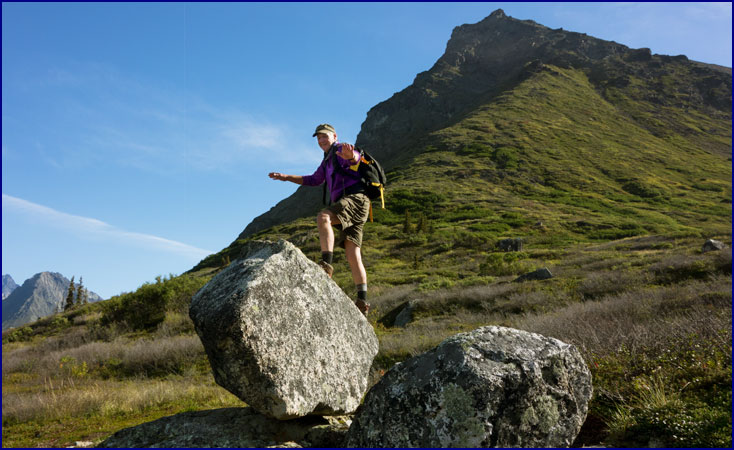
George teetering the rock. |
When we came back down to the boat, we saw Laurel’s
brother in a canoe, paddling, dragging a floating log across the
lake. Laurel had told
us that while working for the park service at Twin Lakes, they
were not allowed to use any power tools or motors. I
thought it was really great that they preserved the integrity of
the wilderness, living a lifestyle similar to what Dick Proenneke
had. We didn’t want
to know what they thought of our motor boat! We
did regret that we had not found an opportunity to take the canoe
out; this calm morning would have been a perfect time, but now we
had to leave. We vowed
to do it next time.
|
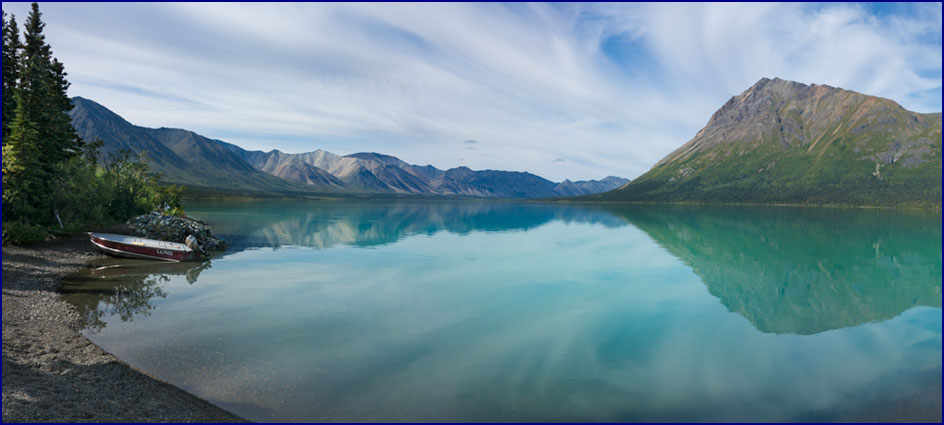
The view from the beach at Dick Proenneke's cabin. |
We
skimmed back across the mirror-perfect lake.
Packing up our stuff, we cleaned the cabin and put away the
boat equipment. We ate
leftover bean soup and blueberry pancakes for lunch.
The jays berated us for not providing bigger morsels, so we
gave them the last of the blueberry pancakes as a special goodbye.
Then we dragged our stuff down to the dock and waited for our air
taxi. The plane was
late, which we didn’t mind a bit – we were very sorry to be
leaving, especially on such a fabulous day.
The jays came down to the swing by the water for some final
ginger snaps. Presently
our floatplane arrived; it was a different pilot this time.
We had less weight than before because we didn’t have the
food, but we were packing all of our garbage out, and the pilot
admonished us for not having it properly divided up to fit in the
floats.
|
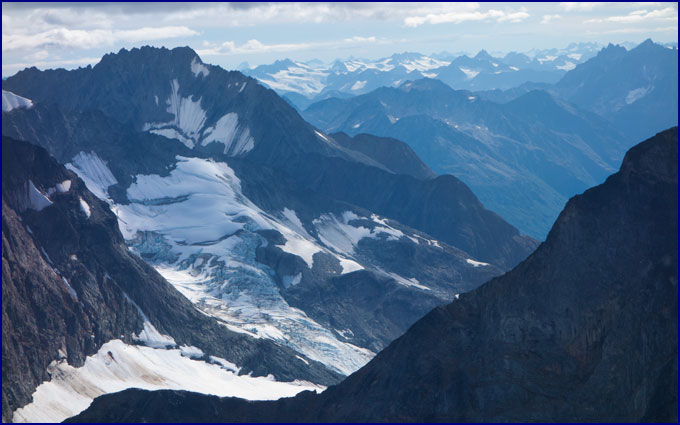
Flying above the peaks. |
Because of the fine weather, instead of flying through Lake
Clark Pass our pilot took the little Cessna up over the tops of
the peaks - he said that the weather is not often clear enough to
do this. On the way up
our wingtips seemed to pass within feet of glaciers, but once
above the mountains we saw the landscape from a completely
different perspective. On
the way in we had been up close and personal with the
mountainsides, but now we were high above them.
Row after row of jagged peaks marched across the horizon
and seemed to go on forever. This
time we were looking down
at the ice flows and glaciers, and into deep valleys with lakes
and braided rivers. If
there are 100,000 glaciers in Alaska, we must have seen half of
them on that flight. Two
huge mountains stood out, towering above the others; our pilot
said they were Mt. Iliamna and Mt. Redoubt, both active volcanos.
As we approached Cook Inlet, we could see Mt. McKinley in
the distance to the north.
|

Mount Illiama |
Back at Lake Hood, Jineen and I said goodbye to George (he was going fishing on Kodiak Island with some friends), and went to the airport to get our rental car for the second part of our trip. We returned the satellite phone and shopped for happy hour supplies; we bought wine, cheese, crackers and bread, but nobody in the grocery store knew what chutney or pâté was. After five days in the wilderness at Twin Lakes, we were suffering from a bit of culture shock being back in the city.
We
drove an hour and a half north to Hatcher’s Pass and checked in
to our cabin at the B&B. This
area is really beautiful, though being convenient to Anchorage it
attracts its share of visitors.
Being back to civilization did have its perks; a hot shower
felt wonderful.
|